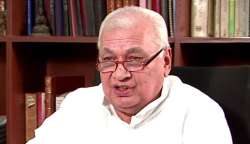Unlocking of Babri Masjid was a 'balancing act' by Rajiv Gandhi government: Arif Mohammed Khan
Senior politician Arif Mohammad Khan today said that in 1986, the then Congress government headed by Rajiv Gandhi had struck a deal with Muslim leaders for the "shilanyas" (groundbreaking) of the Ram Janambhoomi temple in Ayodhya.

Senior politician Arif Mohammad Khan today said that in 1986, the then Congress government headed by Rajiv Gandhi had struck a deal with Muslim leaders for the "shilanyas" (groundbreaking) of the Ram Janambhoomi temple in Ayodhya.
Arif Mohammad Khan urged the Modi government to take the initiative for resolving the dispute after the Supreme Court advised the concerned parties to opt for an out-of-court settlement.
Khan said the unlocking of the Babri Masjid was a balancing act to satisfy the demands of the Hindu community after the Rajiv Gandhi government succumbed to the demands of the All India Muslim Personal Law Board (AIMPLB) on the Shah Bano case in the Supreme Court on maintenance for divorced Muslim women.
"The announcement to reverse the SC judgement (Shah Bano case) and the removal of the locks happened within a span of two weeks. This to most people appeared as a balancing act and they hoped that now both the agitating parties would feel satisfied," Khan, author of "Text and Context -- Quran and Contemporary Challenges" who broke ranks with Rajiv Gandhi in 1985 on the government's capitulation to the Muslim clergy on implementing the Shah Bano judgement that ruled in favour of alimony to divorced Muslim women, told IANS in an interview.
"On the other hand, the removal of the lock practically accepted the disputed structure as a temple and consequently the demand to build a proper temple to carry out the functions that were already taking place inside the building gained more strength. Possibly that led the then government to agree to the shilanyas under the careful watch of the then Home Minister," he added.
Speaking on the politics that went behind the opening of the locks in 1986, Khan said :"AIMPLB asserted that the judgement of the Supreme Court in Shah Bano is a threat to 'Milli Tashakkhus' that is a separate and distinct community identity, and they used very aggressive and threatening language during the agitation... But the announcement to this effect on January 15, 1986, created a severe blowback and within a week the government felt the need to do something to divert attention from the Shah Bano case."
"At that stage, Ayodhya came in handy and the local administration -- that is, the District Magistrate and Superintendent of Police -- personally appeared before the District Court (Faizabad) and stated that removing the lock from the main gate of the disputed structure will not create any law and order problem," he said.
The locks of the Babri Majid were opened in February 1986 on the order of the District Court of Faizabad.
Speaking on the role of Rajiv Gandhi in the entire dispute, Khan said: "After the removal of the locks, I met Rajiv Gandhi and he told me that before the lock was removed the Muslim leaders were informed about it."
Speaking on the role of senior Congress leaders like N.D. Tiwari, Buta Singh, Arjun Singh and P.V. Narasimha Rao (who was the Prime Minister when Hindu fundamentalists razed the Babri Masjid in 2002), he said: "These leaders were of the view that the government cannot play the role of a social reformer, particularly of a minority community."
Without criticising them, Khan said: "From one viewpoint their stand was understandable as they did not want to take any risk of diluting their political constituency."
"In fact, I firmly hold that AIMPLB would never have succeeded in pressurising Rajiv Gandhi to do their bidding, but he was open to advice from his senior colleagues," he added.
(With PTI inputs)